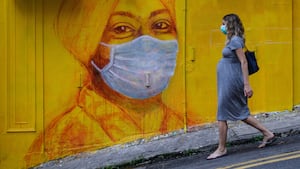COLUMBIA, South Carolina—At one hospital in Charleston, emergency-room nurses are recycling used N95 masks as doctors in other departments pitch in to staff COVID-19 units. At another, shortages have forced health-care staffers to work unprecedented overtime. All told, more than 75 percent of hospital beds are already occupied across the Palmetto State—and the tidal wave of new coronavirus cases is only growing.
Simply put, South Carolina hospitals are under siege.
“We’re going to be worse than New York,” one Charleston ER nurse told The Daily Beast. “But at least in New York, people took the virus seriously. Here, we’re in a war zone that people refuse to accept.”
One of the earliest states to loosen coronavirus restrictions amid the pandemic, South Carolina is now struggling to address its brewing COVID-19 crisis. But while the growth rate of infected residents has exploded over the last week—making the state one of the newest hot spots for the deadly disease—many residents continue to ignore the problem.
Last week, thousands of boaters gathered at Lake Murray to declare their support for President Trump, while organizers of a motorcycle event in Myrtle Beach next week say they have no intention of modifying or canceling the annual tradition.
“Who is staying home? If you look at the roads here, nobody is staying home,” Sonny Copeland, the founder of Myrtle Beach Bike Week, which typically attracts thousands of motorcycle enthusiasts, told The Daily Beast. “Here in South Carolina, we’ve been acting normal since Day 1. We live in real life—this ain’t something politicians want us to do though.”
To date about 898 people have died and 50,548 others have been infected with the virus in South Carolina—with roughly one in five tests returning a positive result. Overnight, the state experienced a 20 percent increase in the number of new cases, with about 1,725 positive tests, while the South Carolina Department of Health and Environmental Control on Thursday announced that more than 75 percent of its total hospital beds are occupied. Of the 7,991 hospital beds currently occupied statewide, about 1,433 of them are being used by COVID-19 patients. South Carolina’s majority-Black communities have been hit the hardest, according to media reports and statistics from the state health agency DHEC.
Anthony Alberg, an epidemiologist at the University of South Carolina in Columbia, told The Daily Beast he’s not surprised the state has failed to contain the pandemic—as its reopening occurred far too soon.
“Early on, South Carolina took the essential steps needed to flatten the curve,” Alberg said. “The problem has been reopening too soon, which has led to a very large upsurge in COVID-19 cases that cannot be accounted for solely due to the increased testing for active SARS-CoV-2 infections.”
South Carolina’s current surge of cases is so bad that it’s now one of the top three worst coronavirus outbreaks in the world. In a New York Times study of the number of daily infections between June 28 and July 5, Arizona and Florida are the two most impacted areas in the world—followed by South Carolina, the kingdom of Bahrain, and Louisiana. Hospitals are overwhelmed, understaffed, and short on supplies—unable to keep up with what researchers believe is the “tipping point” before the state loses control of the pandemic.
“We’ve completely lost control of the situation in South Carolina—and it’s completely embarrassing,” Helmut Albrecht, chairman of the Department of Internal Medicine at the University of South Carolina in Columbia and Prisma Health, told The Daily Beast. “In the medical community, we feel like we are getting completely dumped on.”
Some doctors insist the surge was inevitable, given state officials’ response to the virus. Aside from closing schools, in the first month or so of the coronavirus’ spread in South Carolina, there was very little in the way of a statewide effort to slow the pathogen. As late as the end of March, the Republican-led state government was actively discouraging local public-health efforts. “We affirm that local governments cannot exercise the emergency powers delegated to the governor by the general assembly,” Attorney General Alan Wilson stated on March 27. The general assembly is South Carolina’s state legislature.
Columbia Mayor Steve Benjamin, a Democrat, brushed off Wilson’s memo and continued with local social-distancing measures. “The actions taken by the city are entirely within our authority,” Benjamin said. Republican Gov. Henry McMaster eventually caved and allowed cities to implement public-health measures, while also taking some modest steps to enforce social distancing on a statewide level—such as closing some businesses.
But many South Carolinians chafed under the restrictions. The first major public protest against social-distancing measures in South Carolina occurred in Columbia on April 24. A few hundred people, many of them from out of town, marched or demonstrated from their cars.
On April 24, McMaster was one of the first state officials to begin loosening coronavirus restrictions, announcing an executive order that allowed most retail and department stores to reopen with social distancing. The order came only after three weeks of “actual closure,” one Charleston ER doctor said.
“Nobody really had the time to take it seriously,” said the ER doctor, who wished to remain anonymous for fear of professional retaliation.
At the peak of social distancing in South Carolina in early April, DHEC estimated the population’s mobility to be down 42 percent compared to normal. By comparison, in New York City mobility dropped by more than an estimated 90 percent in late March, though metrics used to gauge mobility varied in the two appraisals.
“The mindset from the government was that the ongoing pandemic was not that big of a deal, and people continued to live life as normal,” the ER physician added. “People went to the beach, they traveled—all without proper social distancing and mask use. Now, our hospitals are paying the price.”
The ER doctor, who works at one of the largest hospitals in Charleston, a city that saw four deaths overnight and 325 new cases, also said that hospital staffers are being forced to treat patients without adequate protective equipment and work overtime.
“It’s only going to get worse here as summer goes on. People flock down here to go to lakes, to Myrtle Beach,” the Charleston doctor added. “We’re just all really unprepared.”
Myrtle Beach, a popular tourist destination along South Carolina’s coast, seems to be one of the biggest problem zones in the Palmetto State. A spring-break destination with a large elderly community, Myrtle Beach has contributed to increasing COVID-19 cases nationwide—including 50 cases around Philadelphia.
An internal state report obtained by ABC News foreshadows that South Carolina’s COVID-19 outbreak has no end in sight. The July 4 report, which warned of the state’s hot-spot status, particularly in coastal counties, said that in Horry County, where Myrtle Beach is located, “cases continue to sharply rise” with “widespread travel to the area contributing to cases.” In Charleston, there is “no sign of cases slowing down,” according to the report.
Locals, however, refuse to let the pandemic that has killed more than 133,000 people nationwide ruin their summer.
“We’re making no changes. Everything is going according to plan,” Copeland, 61, said about the 81st Annual Myrtle Beach Bike Week.
The bike rally, which was moved from May to July due to coronavirus concerns, will begin on July 13 and bring together thousands of motorcycle riders, residents, and out-of-town enthusiasts. Last May, Copeland said about 250,00 to 300,000 bikers came to the event. Even officials are not terribly concerned about the implications of such a large gathering, telling local news outlets that if residents are not comfortable they have the option of staying home.
“The way I look at it, we don’t need the damn government to tell us what to do,” Copeland said. “We are smart enough to look after ourselves. We’re smart enough to know how to take care of ourselves, distance when we ride, and we have common sense.”
“We’re not a bunch of teenagers who are going to hug and kiss on the beach,” he added. “This is about riding motorcycles, being in the wind. This is about enjoying life and riding. This is about common sense.”
Albrecht believes large events like Bike Week are actively contributing to the influx of hospitalizations in the state. Calling the carelessness in the community “concerning,” the doctor added that South Carolina’s biggest problem right now is “community spread” and “things open that shouldn’t be open.”
“Leadership is not only making certain good or bad decisions and they are leading by example,” Albrecht said, adding that he is “pro-opening” and believes it is a citizen’s personal responsibility now to ensure the state does not go into free-fall. “Right now, it’s all about regaining control over the spread of the infection. It’s not rocket science. It doesn’t have to be this way.”
To date, South Carolina does not have a mask mandate despite recommendations from the Centers for Disease Control and Prevention. McMaster’s office did not respond to The Daily Beast’s request for comment about the COVID-19 increase in South Carolina, but the governor has previously bashed some preventative measures, calling mask mandates “impractical” and “ineffective.”
“There’s no power on Earth that can follow everyone in the state around to be sure that they are following the rules,” McMaster said in a June 26 press conference.
While the state government has all but surrendered to the virus, cities are continuing to fight. Columbia, Charleston, Myrtle Beach, and more than two dozen other municipalities have, since late June, passed ordinances requiring people to wear masks while indoors in public. The city-level rules include lots of exceptions—and enforcement on the street level is weak. Columbia delegated enforcement of the mask rule to fire marshals and parking-meter monitors instead of making it a policy priority.
For the Charleston ER nurse, the lack of strong government action is directly correlated to the dire ICU situation in her hospital.
“Asking people nicely to follow the CDC guidelines is not going to change anything,” she said. “At the end of the day, people don’t want to stay inside, wear a mask, or stop living their lives any longer. People can be selfish—and that choice is seen every day in my overflowed hospital.”











